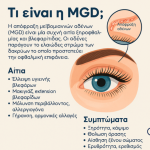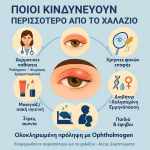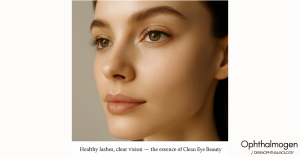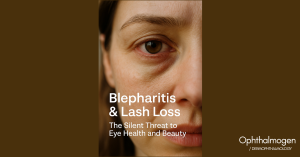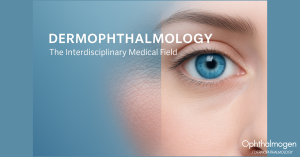
1. How Makeup Can Cause Chalazion
Eyelid cosmetic products increase the risk of MGD, chalazion and dry eye:
- Gland blockage: Makeup particles (mascara, eyeliner, eyeshadow) can clog the openings of the Meibomian glands, preventing the release of essential lipids.
- Contamination of products: Over time, eye cosmetics can become contaminated with bacteria and Demodex mites, raising the risk of inflammation.
- Poor removal habits: Sleeping with makeup leaves residue that irritates the eyelids and obstructs the glands.
2. Risks of Eyelash Extensions
- Glues & chemicals: Adhesives may cause irritation or allergic reactions.
- Cleaning difficulty: Extensions make it harder to clean the lash base, allowing bacteria and Demodex to thrive.
- Increased gland obstruction: Dirt and oils build up around extensions, blocking the Meibomian glands
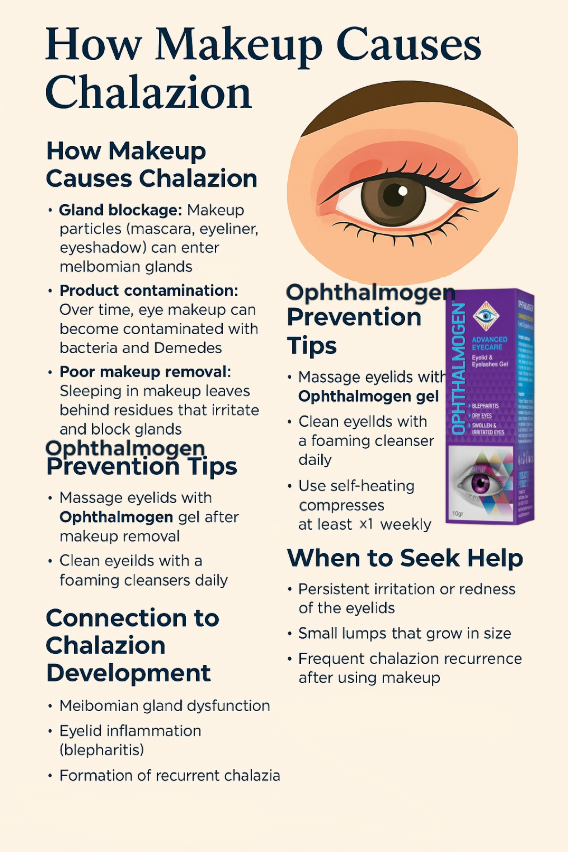
3. Practical Prevention Tips
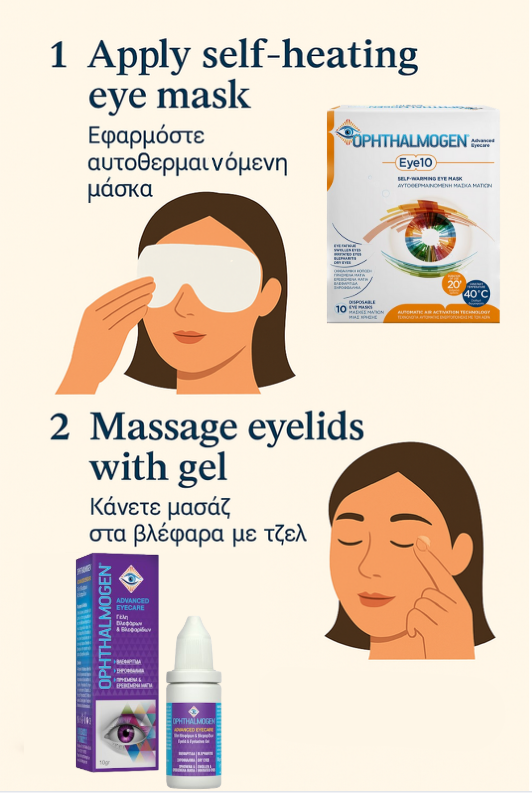
Bacteria and Demodex at the lid margin contribute to blepharitis and dry eye. To reduce risk:
- Always remove makeup before bed. This reduces the chance of gland obstruction or eye infection.
- Be cautious with eyeliner: Pencil eyeliner increases the phase transition temperature of meibum by 4°C, making it harder to liquefy and express → leading to MGD, dry eye and chalazion
- Extra-long lashes: Act as “wind tunnels”, channeling air and particles into the eye, making it drier and more exposed. Heavy false lashes may cause natural eyelashes to fall out.
Daily Eyelid Hygiene
- After removing makeup, massage the eyelids with Ophthalmogen Gel to lower the risk of inflammation, MGD and chalazion.
- Cleanse the eyelids with Naviblef Foaming Cleanser before applying makeup.
- Use preventive self-heating compresses Ophthalmogen Eye10 (once weekly, 20 minutes) to reduce the risk of MGD, blepharitis and chalazion from daily makeup use.
- Apply mascara from the tips, not the roots – ideally only on upper lashes.
- Apply eyeliner along the lash line, not the waterline. Studies show applying eyeliner inside the lash line increases particles in the tear film.
- For eyelash extension users: spray daily with Ophthalmogen Spray to disinfect the lash base and prevent Demodex overgrowth.
- Use Naviblef Daily Care and Ophthalmogen Spray for lash extensions (they do not dissolve glue).
- Replace eye cosmetics (mascara, eyeliner, eyeshadow) every 3 months.
4. Link to Chalazion Development
Improper eyelid hygiene or contaminated makeup products may lead to:
- Overpopulation of Demodex bacteria/parasites on eyelids & eyelashes
- Irritated eyelids, problematic eyelashes
- Irritated eyes (watery, itching, stinging, burning, redness)
- Meibomian gland dysfunction.
- Blepharitis/ Dry eye
- Recurrent chalazion.
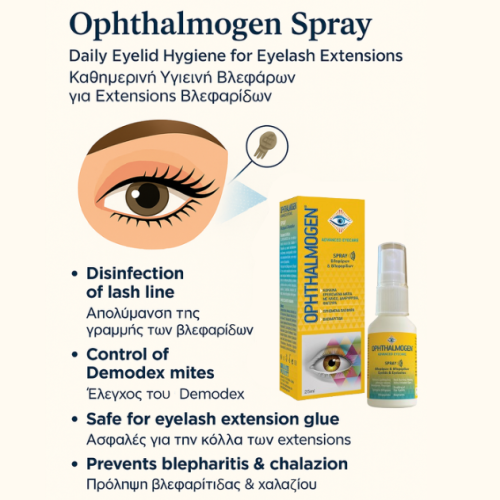
5. When to Seek Medical Advice
See your ophthalmologist if you notice:
- Persistent eyelid redness or irritation.
- Small lumps that grow.
- Frequent chalazion relapses after makeup use.
Conclusion
Makeup and eyelash extensions, if not used and cleaned properly, can increase the risk of MGD, blepharitis and chalazion. With consistent eyelid hygiene and products like Ophthalmogen Gel, Ophthalmogen Spray, Naviblef Foam and Ophthalmogen Eye10 Compresses, you can enjoy makeup safely without compromising your eye health.
All Ophthalmogen products are available in partner pharmacies and at:
https://www.pharmacydiscount.gr/search-results?find=ophthalmogen
📘 Σχετικά Άρθρα για το Χαλάζιο
Chalazion & Psoriasis / Dermatomyositis
Chalazion & Rheumatoid Arthritis (RA)
Chalazion & Thyroid Disorders
Chalazion in Patients with Sjögren’s Syndrome and Autoimmune Diseases
Chalazion and Systemic Lupus Erythematosus (SLE)
Chalazion in Screen Users – How Digital Eye Strain Increases the Risk
Chalazion in Immunosuppressed Patients – Why It Appears More Often and How to Manage It
Chalazion in Patients with Dyslipidemia – Why It Occurs More Often and How to Manage It
Chalazion and Pregnancy / Postpartum: Hormonal and Inflammatory Changes
Chalazion and
Glaucoma: The Invisible Link and the Importance of Prevention
Chalazion in Diabetic Patients – Why It Occurs More Often and How to Manage It
Chalazion – Complete Guide to Causes, Symptoms, Treatment & Prevention
Chalazion and Prevention – A Comprehensive Approach for Healthy Eyelids
Chalazion and Blepharitis – The Hidden Link and the Importance of Prevention
Chalazion Home Treatment – A Practical Step-by-Step Guide
The Best Artificial Tears for Dry Eye, Blepharitis, and Chalazion
Chalazion & Eyelash Extensions – Prevention & Care Guide
Conjunctivitis and Chalazion: How They Are Connected and How to Prevent Them
Οφθαλμική Αλοιφή & Θερμοθεραπεία για Χαλάζιο: Το Ολοκληρωμένο Πρωτόκολλο
Chalazion & Contact Lenses – What You Need to Know
Chalazion and Vitamin A Deficiency: The Link You Shouldn’t Ignore
Chalazion and Menopause: Hormonal Changes and Eye Health
Χαλάζιο στα Παιδιά: Όσα Πρέπει να Ξέρουν οι Γονείς
Who Is Most at Risk of Chalazion – Causes and Prevention
Chalazion and Eye Makeup – What You Need to Know
Warm Compresses for Chalazion – How to Use Them Correctly
Chalazion (Meibomian cyst)

